Prerequisites:
Before you proceed to the steps below, make sure you have the following:
- Computer with an Internet connection.
- PPM Express report pack for MS O365 Planner. Please download it by this link:
PPM Express report pack for MS O365 Planner.pbix
- Power BI Desktop installed and Signed In (Power BI Desktop is a part of the Power BI product suite. It allows you to connect to multiple data sources, transform and model your data, and create reports. Learn more by clicking this link).
Create Power BI Workspace
We recommend creating a new workspace for this report and publishing/uploading it to a newly created workspace or publishing/uploading this report to the same workspace where the main PPM Express Power BI report is already published.
If you have not configured Power BI Reports before, create a new workspace following these steps:
1. Navigate to the Power BI service and click on Workspaces.
Then select Create a Workspace.
2. Create a new workspace, providing all required Power BI information.
- Upload an image that will be used as a workspace cover.
- Type in the workspace name.
- Populate optional description.
- Click Save once you are done.
3. A newly created Workspace is ready. You can now proceed to the next step.
Configuring PPM Express Report Pack for MS O365 Planner
To configure the PPM Express Report Pack for MS O365 Planner perform the following:
1. First, it is required to publish or upload the downloaded report to the Power BI service.
The report can be added to the Power BI service either using the Power BI Desktop app or via the Power BI service. Please select the way that works better for you:
- Open the downloaded file in Power BI Desktop and publish it. Please make sure to log in to the Power BI desktop with the account that has access to the required workspace in the Power BI service.
For instructions on how to publish Power BI reports, please refer to Microsoft documentation. - Open the Power BI service, navigate to the required workspace, and select New => Upload a file.
Note: If you are using Power BI Pro we do not recommend publishing the report to 'My Workspace'. It is recommended to publish the report to a newly created workspace or to any other workspace that you have besides 'My Workspace'. In this way, you will be able to share the report with other members of the team and navigate to the reports from PPM Express. If you publish the report to 'My Workspace' (in case you are not using Power BI Pro) it won't be possible to share it with other team members and you will be the only user who can navigate to the report from PPM Express.

2. After publishing/uploading the report, we need to configure its Semantic model (former dataset).
For this purpose, we will open PPM Express => Reporting first.

PPM Express has an open protocol that allows querying data - PPM Express OData.
Navigate to the PPM Express Report Settings page. In the Report Settings, you can find the OData feed URL – this is a URL link to PPM Express instance OData that you can use to connect to PPM Express OData.
Copy the URL from the OData feed URL field.

3. Open the Power BI service Workspace where you have published the report, navigate to the published Semantic model (former dataset), click on the ellipsis button, and choose Settings.
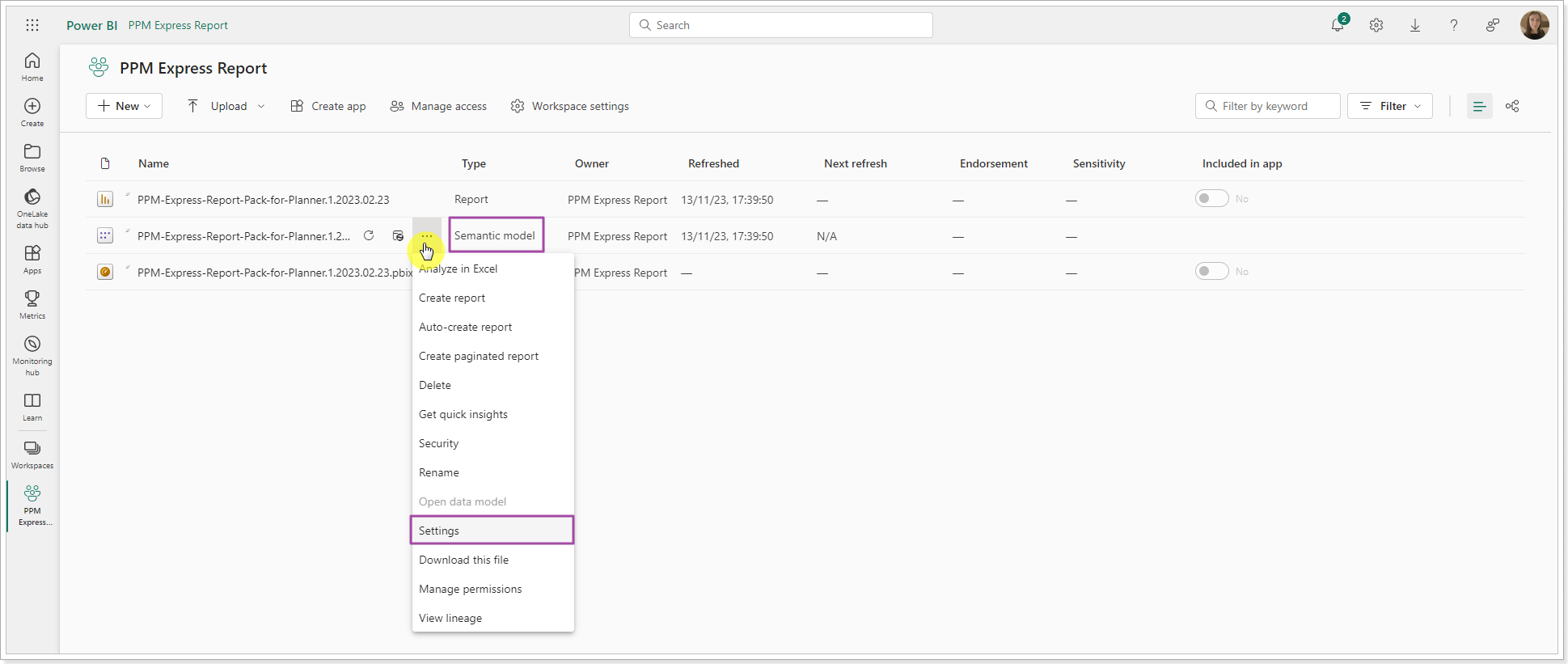
4. On the Settings for published Semantic model (former dataset) page, open the Parameters section and paste the OData URL to the PathToPPMX parameter.
Click Apply.
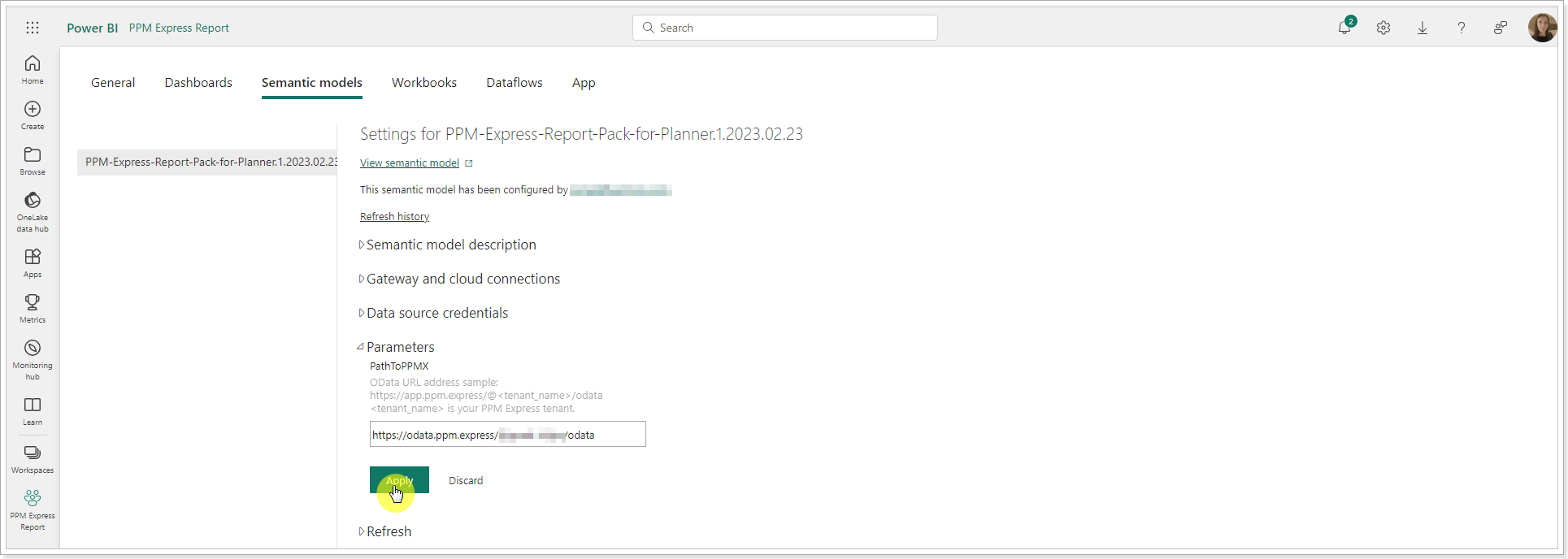
5. Return to the PPM Express Report settings page.
In order to be able to create reports, a password is required. In PPM Express, you can create a token, that can be used as a password.
To create a token for the Power BI report, perform the following actions:
Click Create access token under the OData feed URL.
Click the Generate Token button.

Copy the token.
Make sure you copy the above token now. We don't store it and you will not be able to see it again.

Copy the created token and switch back to Power BI Settings for PPM Express page.
6. Open the Data source credentials section. Click on the OData => Edit credentials link.

Configure PPM Express Report Pack for Office 365 Planner menu will appear.
Paste the token copied from the PPM Express Report settings page to the Password field.
Fill in the User name field with any user name.
Please make sure to select a Basic authentication method.
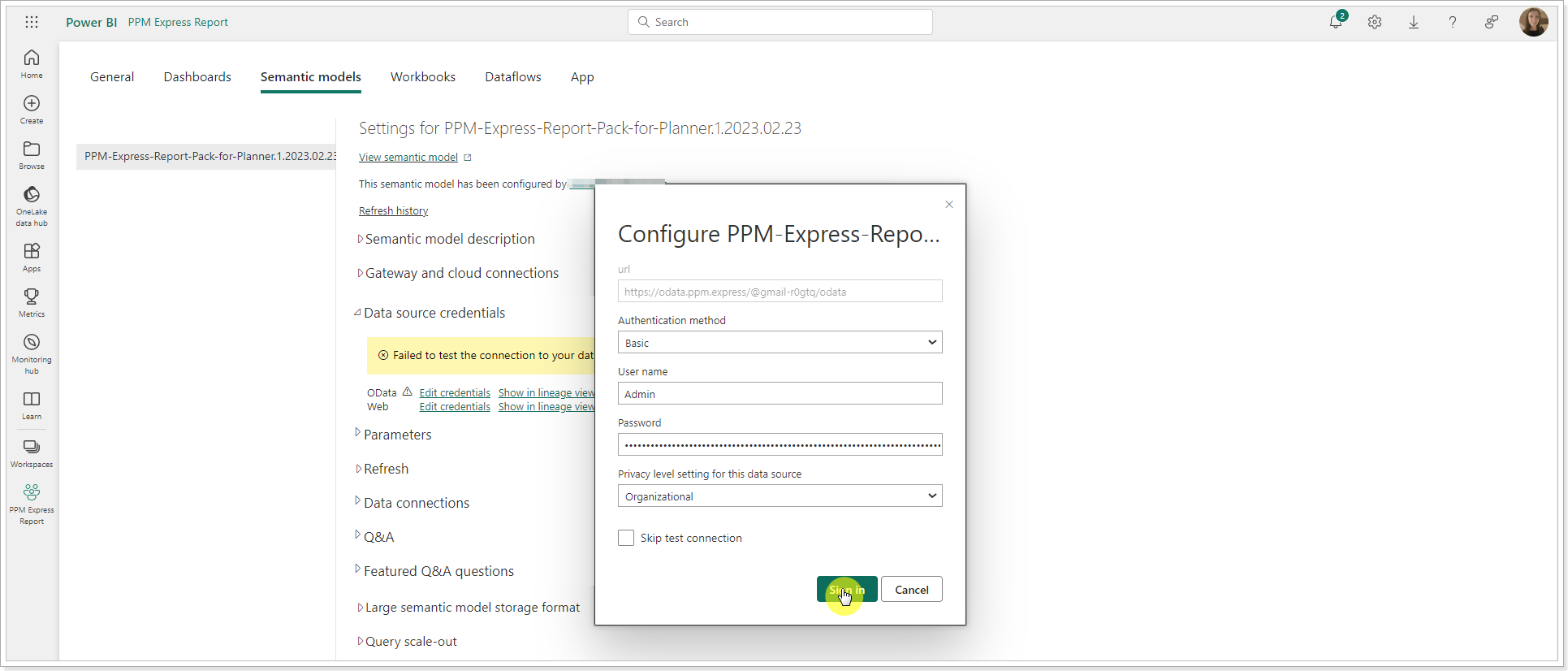
7. Next, we need to establish a connection to the Web. By establishing a connection to the Web, we ensure that the latest version of the report pack will be available for download.
Click on the Web => Edit credentials link.

Select an Anonymous authentication method and Organizational privacy level. Click Sign in.
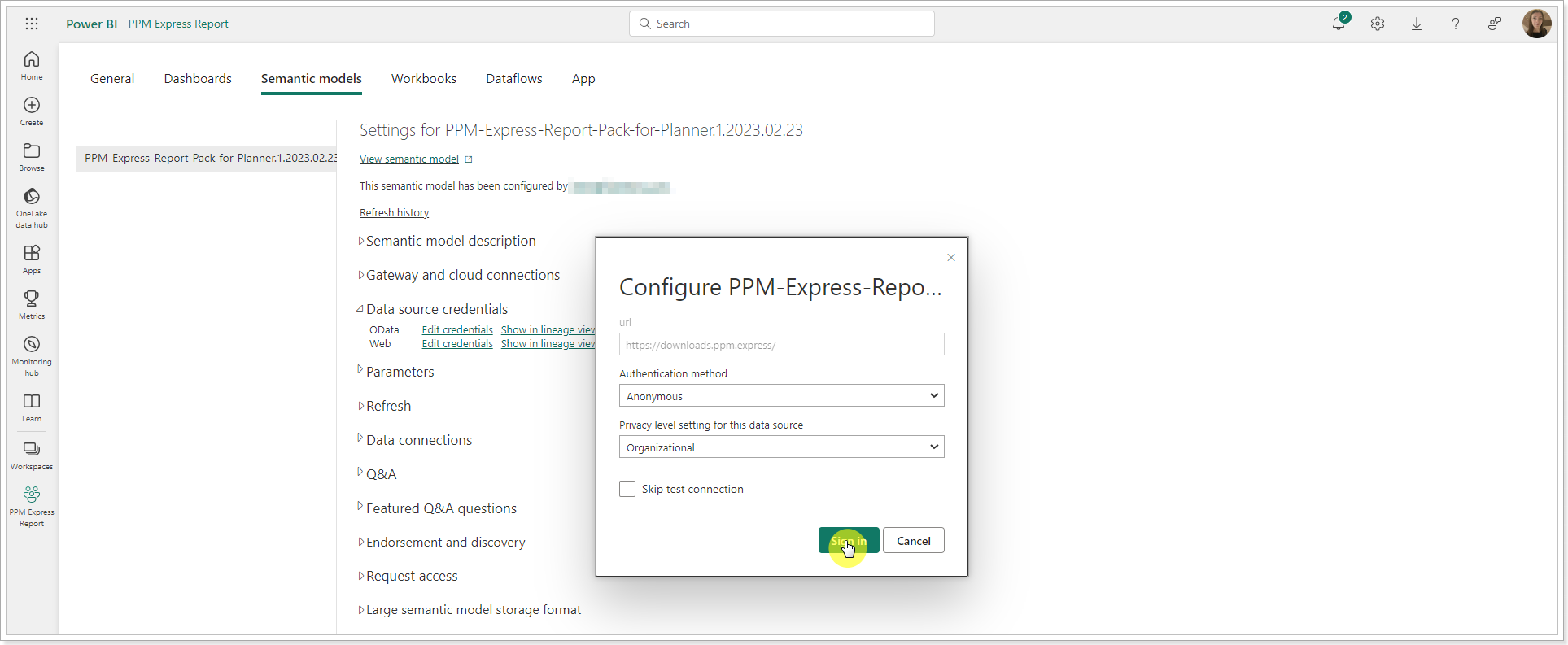
8. It is recommended to set up the Automated Data Refresh at once so that the latest data is displayed for the report. For this, click Scheduled Refresh in the Settings for PPMX.
In the Keep your data up to date section, toggle the switch to On.
You can also choose the Refresh Frequency, Time Zone, and Time when the refresh will take place.
Click Apply once you are done.
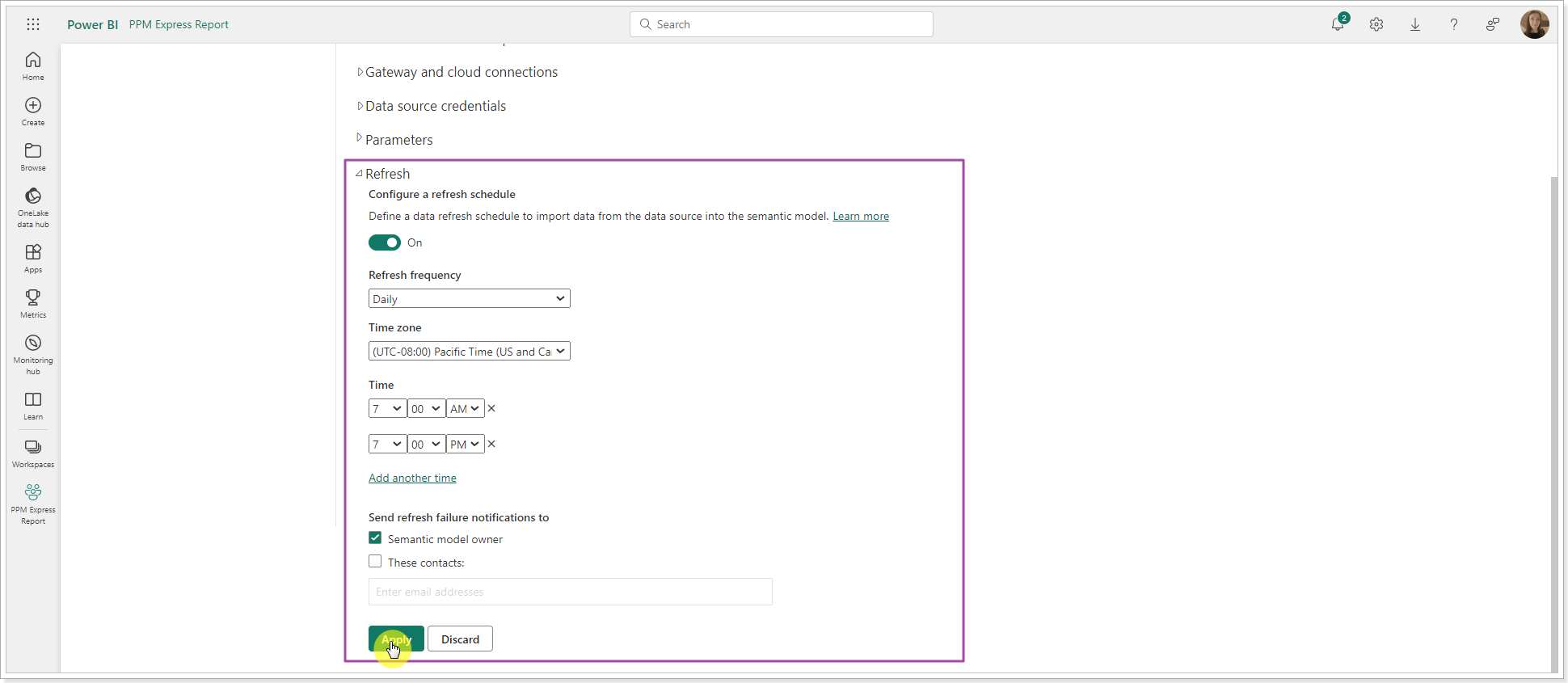
Also, it is required to launch data synchronization for the report at once so it starts displaying data for the report. For this purpose, open the Workspace where you have published the report, and navigate to the published Semantic model (former dataset), and click the Refresh button.

Adding the report to PPM Express pages
PPM Express provides the ability to add custom reports to the Report Settings page and to navigate to the reports from different PPM Express pages directly (Projects, Portfolio, Programs, Resources, Objectives, and Challenges).
To add your report to the required pages in PPM Express, it is required to add the Office 365 Planner report pack as a custom report to PPM Express and provide the report home page URL to PPM Express. If you select to open any PPM Express report from these pages, the Power BI service will be opened in a new tab, and information for the selected report will be displayed.
Navigate to the published PPM Express report in Power BI, open its Home page, and copy its URL, including the Report ID (which comes after the 'report' word) and excluding the rest.
It is essential because you publish a report file using your own Power BI account. The published report resides in the workspace of the account you used. To let the PPM Express App navigate to the published report in the Power BI service, the PPM Express App has to be aware of the report URL address.

Return to the PPM Express Reports Settings page and click on the New Custom Report button.
On the New Report page, type in the name of your report and paste the report URL into the Report URL field.
In the Scope field, select the PPM Express pages where this report will become available.

Click Create Custom Report.
The report will become available on the Report Settings page and other PPM Express pages you selected in the Scope field.
If you need to export the report, we recommend exporting it to PDF first: Export => PDF.

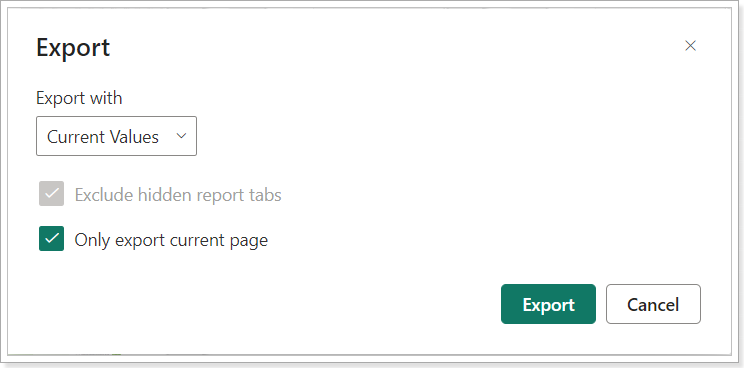
If you click File => Print this page instead, please enable the 'Background graphics' checkbox in the print preview dialog to get all the boxes to appear and include colors.
